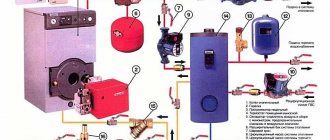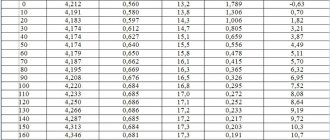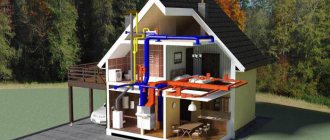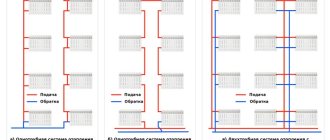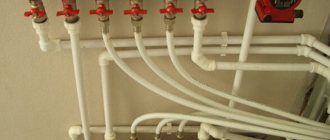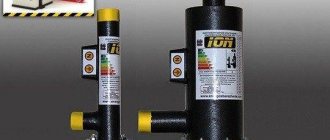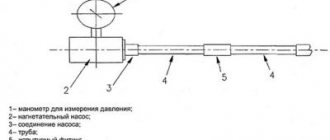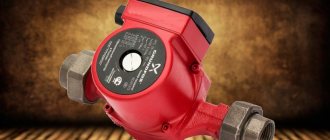An individual heating system must operate continuously in winter, even in the absence of residents, in an economical operating mode. But if the owners have left a country cottage or country house for a long time, unforeseen situations may arise that lead to freezing of water in the heating pipes, and in this case the question becomes relevant - what to pour into the heating system of a private house.
The task is complicated by the fact that there are several options for replacing water with frost-resistant liquids that have different chemical properties and physical characteristics. An accurate calculation of the volume of coolant in the system is also necessary - this will allow you to correctly determine the required amount of non-freezing liquid for operation in the heating system, and accordingly save money and time.
Rice. 1 Heating system in a private house
What is coolant and what types are there?
A coolant is a liquid or gaseous substance intended to transfer thermal energy; in an individual heating system at home, only a liquid working fluid is used.
The following types of coolants are poured into the home heating system:
- Water. The most affordable and versatile coolant, which does not require financial costs for its purchase and is used in most heating systems, has the highest heat capacity among liquid substances.
- Antifreeze. Two types of antifreeze are used to transfer thermal energy - ethylene glycol and propylene glycol. They have a low crystallization temperature and are diluted with water in a certain ratio - this allows you to change the freezing point of the liquid.
- Antifreeze mixtures. The most popular antifreezes, ethylene glycol and propylene glycol, have different chemical and physical properties. Some manufacturers add glycols to their composition to produce liquids that combine the advantages of the two components.
- Automotive antifreezes. Ethylene glycol is one of the main components of automobile coolants, so you can use the well-known Antifreeze for heating your home. In his stamps, the numbers 40 (blue) and 65 (red) indicate freezing temperature. During operation, the antifreeze solution changes color to blue-green, then green, yellow, and finally becomes discolored (more precisely, it becomes dirty brown due to rust deposits). This indicates a decrease in its performance and the need for replacement. The normal operating temperature for the operation of Antifreeze is considered to be up to 95º C; if this threshold is exceeded, the service life of the liquid drops sharply.
Fig. 2 Antifreeze - types
- Other substances. To lower the freezing point of water, you can use any salt solutions (sodium, potassium, calcium chloride), alcohols, glycerin, glycols, aniline and many other chemical components. Water with 40% ethyl alcohol content is considered a very good antifreeze, but its use is quite expensive and is limited by high volatility and flammability. Cheaper methyl alcohol, which is dangerous to use as a coolant due to its high toxicity, has similar properties.
There are glycerin-based antifreezes on the market - under no circumstances should these compounds be used in the heating system, they are temperature unstable, decompose with the formation of components harmful to materials, and make it difficult to adjust the heating boiler.
Basic requirements for coolant for heating country houses
The coolant that should be poured into the heating system of a country house must have the following properties:
- Have a high heat capacity. This indicator characterizes the property of a substance to accumulate thermal energy - the more the working fluid absorbs energy, the more of it will be supplied to the heating radiators.
- Viscosity. The working fluid must have a low viscosity - in this case, the electric pump will require less electricity to supply the liquid.
- Environmentally friendly. Many liquids that have suitable physical parameters for use as a coolant are not used as a working fluid due to the high risk of harm to human health.
- Safety. The heat-conducting liquid must not be explosive or flammable.
Rice. 3 Single-pipe heating circuit with open expansion tank
You may be interested: Single-pipe heating system - pros and cons, popular schemes
- Neutrality. The coolant should not have a harmful effect on pipes, boilers, heating equipment, radiators, leading to their corrosion, chemical damage and, accordingly, rapid failure.
- Price. The price of the heat-conducting fluid is the most important parameter when choosing suitable materials; many of them with good physical characteristics are not used in systems because they are too expensive.
- Temperature. The heat-supplying fluid must withstand the maximum and minimum operating temperatures, as well as their lower and upper limits, taking into account emergency situations (power outage, equipment breakdown, line damage).
- Lifetime. All antifreezes change their chemical properties during operation and their technical parameters deteriorate. When used in automotive applications, it is recommended to change them every 3 to 5 years; this parameter must also be taken into account when used as an antifreeze liquid, choosing a composition with the longest service life.
Rice. 4 Single-pipe heating system with sealed circuit
Ideal coolant - myths and disappointments
Let's start with the fact that the ideal coolant for heating a private house does not exist in nature, just as nothing ideal exists. One will be expensive, the other will be ineffective, and the third will quickly corrode all the gaskets, while the fourth will break a couple of sections of the home pipeline when it freezes. And in country houses, which are often used for temporary residence, pipe ruptures are becoming quite common.
A good heating fluid must have the following qualities:
- Corrosive safety – the liquid poured into the system should not lead to the formation of corrosion. Many coolants are truly safe for almost all components, both metal and plastic, only they have other disadvantages. The same water can be relatively safe or aggressive, corroding iron or not having any effect on it;
- Fluidity over a wide temperature range is a very important property for heating systems in country houses. A good coolant should remain liquid at any temperature. Water is no longer suitable here - it freezes at 0 degrees and even causes pipes to rupture, as it tends to expand when cooled. Ethylene glycol becomes more viscous at subzero temperatures, which cannot be said about propylene glycol;
- Affordable price - you must agree, this is an important factor, but it is very vague. For example, water can be free or very expensive. By collecting it from a well, we will get the simplest coolant almost free of charge, but distilled water in the right quantities will hit our pockets. But we will tell you how to normalize water for its use as a coolant in heating systems of country houses;
- Minimum amount of salts - the less salts, the less deposits on the walls of pipes and radiators. For example, distilled water is famous for its lack of salt content, while ordinary water may contain a huge amount of salt compounds invisible to the naked eye. During the heating process, chemical reactions occur in the coolant, as a result of which some of the salts become insoluble, precipitating in the form of a terrible growth;
- Minimal toxicity is a very important property, since some coolants are very toxic. Not only is it dangerous to take them internally, but their vapors and even contact with the skin are dangerous. A typical example of this is inexpensive ethylene glycol, which is poisonous to humans. An alternative is propylene glycol, but it is more expensive;
- Temperature resistance - a good coolant for the heating system of a country house should remain itself at any temperature. For example, water should remain water and not turn into alkali or some other aggressive substance. But if nothing happens to the water, then organic compounds, which include glycerin, ethylene glycol and propylene glycol, can decompose when heated.
The most important parameter of the coolant is its cost. Water from the tap, from the nearest river or well is almost free or extremely cheap, while distilled water will cost you money.
There is no ideal coolant for heating. See for yourself - water at 0 degrees freezes and expands, threatening to rupture the heating system. Ethylene glycol will eliminate this effect, but it is poisonous. Propylene glycol is not toxic, it is harmless, but expensive. Glycerin does not seem to be very expensive, but it has a destructive effect on rubber gaskets. In other words, there is some kind of “but” everywhere. It seems like water gets under the ideal coolant, but because of it, the heating system of a country house can become overgrown with salt deposits.
Salt build-up in the heating system can be washed off, but this is expensive or ineffective, because sometimes the layer is so thick that it is useless to fight it.
Water as a coolant
The use of water in the heating system is optimal if people constantly live in the house - even if there are some problems or a long power outage in the winter, if you cannot quickly fix the problem and connect the electricity, you can simply drain the water from the system.
The ideal option for filling the heating line is distilled water, but obtaining it or purchasing it in large quantities is too expensive. A way out may be to collect rainwater and use it further after filtration; you can also soften the water by boiling or use chemical reagents for this.
Pros and cons of water as a coolant
Water is the most common element among heat transfer fluids used and has the following properties:
- Availability. Water is everywhere, it costs practically nothing, and in emergency situations it can always be drained and the system refilled.
- High specific heat capacity. Among all liquids, water has the highest heat capacity with an average value of 4200 J/kg*K. (4.2 KJ./kg.*K.) - this means that it heats up slowly and cools down slowly.
- Low viscosity. Water has a low kinetic viscosity of 1.006 m2/s (10-6) at a temperature of 20º C, with increasing viscosity it decreases and at a boiler operating temperature of about 70 C. this indicator has a value of about 0.4 m2/s .(10-6). This means that there is less resistance to water as it is pushed into the system by the impeller of the electric pump.
- Low coefficient of volumetric expansion. When heated, water increases slightly in volume; compared to zero temperature at 80 degrees, its volume increases by 2.8%.
- Environmentally friendly. The use of water is harmless to health; in case of emergency leaks, it will not cause harm to human health.
- Neutrality. Water is chemically neutral in relation to all synthetic materials; it does not have a harmful effect on the currently widely used pipelines made of cross-linked polyethylene (metal-plastic) used for heating systems.
Rice. 5 Physical properties of water
The disadvantages include the following properties of water:
- High freezing point. This is the main drawback that does not allow the heating system of the house to be operated in the off state in winter.
- Corrosive effect on steel. The use of water does not allow the use of cheap steel as a pipeline material for a long time; it is necessary to use pipes made of more expensive materials and plumbing fittings made of non-ferrous or stainless alloys.
- Scale. As the temperature rises, the salts contained in the water settle on pipes, radiators and plumbing fixtures - this leads to a decrease in the cross-section of the working channel and disruption of the shut-off and control valves.
Which coolant is better to use in the heating system: features of using water
If we talk about water as a liquid used to transfer heat from a source to radiators, then this option can confidently be called ideal. Its heat capacity and fluidity are extremely high, so that heat can be delivered to the radiator in the required quantity without any problems.
Many people are interested in the question of what kind of water is best to pour into the heating system. In this case, the answer is simple - ordinary tap water is suitable for closed heating systems. Of course, its composition can hardly be called ideal, and one way or another, it contains salts, as well as a certain amount of mechanical impurities that can settle on the equipment. However, this process will happen only once, and given that ordinary water can circulate properly through the heating system for years and does not require replacement, the damage will be insignificant. Simply put, the amount of precipitation that appears in the system simply will not be able to somehow affect its operation.
When using a closed heating system, it is necessary to control the coolant level
You need to pay more attention to the choice of water for closed-type systems, since during the operation of the system, partial evaporation of the liquid occurs, and water must be periodically added. As a result of this, the concentration of salts and impurities will constantly increase, which, accordingly, will lead to the accumulation of more sediment on the internal surface of the equipment. Therefore, for systems that have an expansion tank, you need to use distilled or purified water.
Of course, constantly adding distilled water to the system is quite expensive, and it is not always available in the required volume. Therefore, filtered water can be used as an alternative.
Important! The most negative impact on the heating system is caused by hardness salts, as well as iron contained in water. All kinds of mechanical impurities are also not useful. Therefore, you should pay special attention to this during the cleaning process.
For an autonomous heating system, it is recommended to use only clean water without impurities
What to do before adding water to the heating system
You can prepare water for use yourself. This will take some time, but it will save you from having to spend money on buying distilled water. Here are some simple recommendations:
- First of all, the required amount of water needs to be collected in a container of suitable volume and allowed to stand. This will allow most of the iron to settle to the bottom;
- After the water has settled, it must be carefully poured into another container and boiled without covering it with a lid. Thus, magnesium and potassium salts are eliminated.
Water prepared using these simple tips can already be considered sufficiently prepared for use. Of course, carrying out such procedures every time is quite tedious, so you can add already distilled or filtered water, but as an initial fill, this option is excellent.
Water for filling a closed-type heating system must first be purified
What is antifreeze and its types
Antifreeze is a class of liquids that cannot crystallize at low temperatures; their main purpose is to cool automobile engines and operate in low-temperature installations.
There are two main types of antifreeze: propylene glycol and ethylene glycol (glycerin-based formulations are also commercially available); they have different chemical and physical properties and areas of application.
The use of non-freezing liquid in heating systems is justified in cases where the owners of individual houses are absent from them for some time in the winter - in the event of an emergency (breakdown, power outage), the heating system may defrost. As soon as the temperature of the water in the pipes drops to zero degrees, it will freeze and expand by 10%, due to the lower density of ice compared to water by a similar amount. In this case, you will have to change the entire pipeline, completely filled with water, heating radiators and a heating boiler - the losses will be enormous.
Rice. 6 Physical properties of glycols and freezing points of antifreezes
Pros of using antifreeze
In addition to preventing the pipeline system from defrosting, the use of antifreeze has the following advantages:
- The temperature range of operation of antifreeze compositions for heating systems, which lies in the range from -70º to +110º C, ensures the preservation of the pipeline at any low temperatures existing in nature and effective operation as a coolant.
- When the cooling temperature of glycols is below crystallization, they become jelly-like, expanding slightly in volume - this does not lead to defrosting of the system and its failure. After the pipes have thawed, the liquid can be thawed and reused without loss of quality.
- The presence of special additives (corrosion inhibitors and others) in the glycol composition prevents the appearance of scale, rust, foam, and airing, thereby increasing the service life of the system.
- The use of dyes makes it easy to detect leaks, and a change in the color of the fluid indicates the need to replace it.
Disadvantages of using antifreeze
The use of antifreeze has the following disadvantages:
- When using antifreeze compounds, it must be remembered that ethylene glycol antifreeze is poisonous; the lethal dose for humans when ingested is 2 mg. per 1 kilogram of body weight. In this regard, environmentally friendly and absolutely safe propylene glycol was developed.
- The big disadvantage of non-freezing liquids is their too high price; a standard 20-liter container of ethylene glycol with a maximum temperature of 65º C costs on average about 30 USD. A 20-liter canister of propylene glycol with a maximum temperature of -30º C has the same cost - in fact, this means that the propylene glycol composition costs 2 times more.
- The use of relatively inexpensive poisonous ethylene glycol is impossible in a house with an open expansion tank.
- Non-freezing liquids have a limited service life, on average it is 5 years or 10 heating seasons, after which the liquid must be drained, the pipeline flushed and a new composition filled in, and when using poisonous ethylene glycol, the issue of its disposal will have to be additionally addressed. This procedure leads to significant financial costs and loss of time.
Rice. 7 The influence of the percentage of ethylene glycol in a solution on its crystallization temperature
- The use of low-quality antifreeze or its use after the expiration of its service life can cause damage to water supply fittings, clogging of pipes and fittings - there are a considerable number of similar examples on the Internet.
- One of the critical disadvantages of using antifreeze compounds is that many boiler manufacturers refuse the consumer further warranty service after adding antifreeze to the system.
- When using glycols, you will have to install a more powerful circulation pump; propylene glycol will require an increase in its pressure by 10% and productivity by 60%; similarly, a larger expansion tank will be needed.
- It is not recommended to use propylene glycol compounds in electrolysis boilers (Galan) and heating systems with galvanized pipes.
Filters and purification systems for water preparation in the heating system
If for some reason it is not possible to buy purified and distilled water for the heating system, then it can be prepared using special filters and systems. This list presents the simplest and most affordable filtration systems that will be stationary and purify water continuously and with minimal control from the owner of the house.
- Polyphosphate filter
A simple and convenient means of protecting your boiler from the formation of scale and lime deposits. Average price - 3,500 rubles. Consumables - polyphosphate - RUB 1,500/bag. Cannot be used for the water supply system, only for the heating circuit, polyphosphate is toxic!
- Electromagnetic filter water softener "AquaShield"
A device for electromagnetic (electronic) treatment of water and hardness salts to prevent the formation of scale, lime and rust in the heating system circuit and boiler. Simple installation without “inserts”, low price, no maintenance or control on the part of the owner, absolute safety and environmental friendliness. work from 220 V network.
- Mechanical filter "Honeywell"
Removing large impurities of scale, rust, iron and sand from water. The highest German quality, reliable components. Water hammer-resistant replaceable filter element. The downside is the high price.
Be sure to watch this video, which explains in professional language how and what kind of water is best to use for the heating system - anti-freeze, distillate or simple tap water, as well as the dangers of unprepared water for a heating boiler and its elements.
Equipment Features
In household systems of this category, the main function is performed by the heating apparatus. As a rule, two circuit diagrams are used. The first is a special device made of tubes with plates that removes heat from air heated by an open flame. It should be noted here that the working ducts have a small diameter. They become clogged with mechanical impurities, the removal of which will be accompanied by significant difficulties.
The second common design is a boiler. Here, a large tank is used for heating, in which heating elements are installed. Their operation is controlled by sensors that record temperature changes.
When choosing such equipment, you need to pay special attention to what kind of water to pour into the heating system of a private home. The fact is that in the presence of dissolved calcium compounds, scale forms on the surface of the heating elements. This layer has a durable structure with a large number of pores. It is difficult to remove even with considerable force. Heat dissipation will gradually deteriorate until the metal body of the heating element is destroyed. Water will penetrate inside and cause a short circuit.
To move liquid in forced-type systems, one or more pumps are installed. These devices are not drainage modifications, so they can be damaged by mechanical impurities. The same contaminants can block the operation of Mayevsky taps and automatic valves that remove air. Gas bubbles interfere with the normal operation of equipment and impair performance. Such problems are accompanied by increased operating costs.
The small sizes of radiator ducts and pipes compared to industrial analogues become clogged not only with scale. Various forms of organic iron create quite a lot of trouble. Sand and other abrasive components scratch the walls of aluminum heating devices. This provokes the development of corrosion. All this is necessary in order to understand what kind of water is poured into the heating system, as well as what pressure should be there.
Disadvantages of preventive measures
Is it worth thinking about what kind of water to pour into the heating system of a private home? Isn’t it easier to check the condition of individual equipment components from time to time and remove dirt as needed? Let's try to answer the question of which water is better for heating through a detailed study of typical regulatory measures:
- A technical endoscope is not suitable for examining internal surfaces. Devices of this type are not small enough to penetrate the thin tubes of heat exchangers and other parts of household appliances.
- Calcium deposits are removed using acids. Weak compounds act too slowly, so they are heated. Unpleasant and harmful substances enter the indoor atmosphere.
- Strong acids destroy welded joints and metal parts. Here, as at the inspection stage, visual control is difficult. Work operations are performed with low accuracy and provoke the occurrence of various defects.
- In some cases, it is necessary to dismantle products to immerse them in the cleaning solution.
These factors help us understand the complexity of the problem. Professionals using specialized equipment and carefully selected mixtures spend several hours flushing the heating system of a private and country house. Even they fail to calculate their actions in such a way as to prevent damage to individual parts. It is for this reason that specialized teams are equipped with soldering irons, other repair tools and consumables.
Repair: what needs to be taken into account to make the right conclusions?
Slow scale growth is dangerous. Electricity (fuel) consumption increases unnoticed. Therefore, emergency situations arise unexpectedly for users. It should be noted that restoring performance in winter is expensive. All necessary operations must be completed as quickly as possible and precisely before the question of what kind of water is best to pour into the heating system of a private house and what temperature to maintain there. Costs will increase significantly if part of the pipeline has to be removed from the concrete screed. It can be damaged by frozen water inside.
Modern Baksi boilers are complex units. Using built-in automation, the combustion process is controlled. To minimize the consumption of fuel resources, data on room and outside temperatures and other operating parameters are analyzed. Experienced specialists can provide high-quality setup with reliable guarantees. This should not be forgotten when calculating total costs!
It is worth noting separately the features of new heating boilers. To reduce costs and improve their own economic performance, some manufacturers make individual units non-dismountable. This means that they have to be completely replaced instead of repaired. This approach reduces the time for repairs and restoration of equipment functionality, but increases the temperature and overall costs of the customer for the corresponding services. To ensure that clients contact only specialized workshops, they create unique fasteners and non-standard parts.
Comparison of antifreeze with water
Antifreeze compounds used in heating systems are inferior to water in all respects:
- They have 10% lower thermal conductivity - this means that in order to transfer the same amount of heat as water, the speed of their movement through the pipes must be 10% greater.
- The viscosity of some antifreezes is 5-10 times higher than that of water, so the pump will need to apply more kinetic energy (electricity costs will increase) to move the liquid through the pipes.
- Antifreezes have high fluidity, that is, they will penetrate through small cracks in which water was previously retained - this can lead to additional leaks, this disadvantage is eliminated by the use of high-quality connections and seals (paronite or Teflon gaskets).
- The coefficient of thermal expansion of ethylene glycol is 1.5 times greater than that of water, that is, at a temperature of + 80º C it can reach 4.5% of the total volume and in some cases it will be necessary to install a large expansion tank.
Rice. 8 Comparison of the characteristics of antifreeze and water
Main types of antifreeze and their properties
Antifreeze is used to prevent the heating system from defrosting; their main types are aqueous propylene glycol and ethylene glycol solutions, the freezing threshold of which depends on the ratio of glycol and water.
Composition of antifreeze
Low-freezing liquids consist of an active substance (antifreeze 60 - 65%), distilled or deionized water (about 30 - 35% of the total volume) and 3 - 4% special additives (corrosion inhibitors), which are supplied by large foreign chemical concerns (BASF). Sometimes the manufacturer supplies the market with cheap low-freezing liquids that contain diethylene glycol, which has low chemical stability and a correspondingly short service life.
Ethylene glycol antifreeze - when to choose
Two main types of ethylene glycol antifreeze liquid (red color) are supplied to the market, the crystallization temperature of which is -30 and -65º C; despite the toxicity, it can be used without great concern in closed heating systems. In a closed circuit, it does not pose a big threat to the health of children and animals, unlike medications and household chemicals that are located in accessible places at home.
Ethylene glycol is harmful only if it enters the body (children may be attracted to its sweet taste), long-term inhalation of its vapors causes short-term health problems, and if it comes into contact with the skin of your hands, in the event of eliminating a leak or a pipeline rupture, you will simply need to rinse them with water.
Rice. 9 Comparison of freezing temperatures of antifreezes
Propylene glycol antifreeze when to choose
The positive qualities of propylene glycol are its low coefficient of thermal expansion and absolute harmlessness to humans (it is a food additive), so it can be used in circuits with open expansion tanks. A green propylene glycol composition is supplied to the market (ECO is often added to the name) with a freezing point of up to -30º C; to obtain a standard freezing point within 20 degrees it should be diluted with water by approximately 40%. The disadvantages include low thermal conductivity (30% less than that of water), so when using a low-temperature liquid, the pump performance will have to be increased.
Triethylene glycol antifreeze - when to choose
The main difference between triethylene glycol and other coolants is its ability to withstand operating temperatures up to 170 - 180º C, and high viscosity (2 times more than ethylene glycol), which makes its use as an antifreeze in high concentrations problematic. Triethylene glycol is used as an additive in mixtures with other antifreeze liquids in antifreeze compositions to increase the upper temperature threshold.
About the pros and cons of glycol antifreeze
The main advantage of artificial coolants based on glycols is the preservation of the liquid phase at subzero temperatures. We list other positive aspects of using antifreeze in closed water heating systems:
- coolants do not contain calcium and magnesium salts, which form scale inside the heat exchangers;
- due to the penetrating ability of glycols, the effect of lubrication of moving parts occurs, ball valves and thermostatic valves do not sour, the fittings last longer;
- the boiling point of antifreeze 103-106 °C delays the moment of vaporization and airing in case of overheating of a solid fuel boiler;
- When the temperature drops below the freezing threshold, glycol solutions turn into a gel mass.
Note. The paragraph about scale implies that the “anti-freeze” is diluted with demineralized distilled water.
When glycol mixtures freeze, they form a slurry that is unable to rupture pipes and heat exchangers.
Let us explain the last 2 points. Ordinary water, often poured into the heating system of country houses, begins to boil at 96-98 ° C, actively releasing steam. If the circulation pump is on the TT boiler supply, the steam phase penetrates the chamber with the impeller, water pumping stops, and the boiler completely overheats. A higher boiling point of antifreeze will delay the moment of the accident.
Unlike water, glycol hardened in the cold does not expand and does not destroy pipe walls. In the event of freezing, the only unit that will suffer is the forced circulation pump. The crystallizing gel will jam the impeller and the motor will burn out.
Unfortunately, there are plenty of disadvantages to non-freezing substances:
- Ethylene glycol is poisonous and requires careful handling and disposal of the solution. Glycerin and polypropylene glycol are harmless.
- The heat capacity of the “anti-freeze” is 15% less. To deliver the required amount of heat to the batteries, the liquid flow will have to be increased.
- The viscosity of antifreeze creates additional hydraulic resistance. You will need a more powerful and expensive circulation pump.
- Good turnover is a double-edged sword. Glycols penetrate through the slightest leaks, from which plain water cannot flow.
- Coolants and additives decompose during operation, losing their frost-resistant properties and forming flakes of sediment. The maximum service life of 1 refill is 5 years, then the heating is flushed and replaced.
- When using antifreeze, many gas boiler manufacturers void the warranty of the purchased product.
Glycol liquids are poorly compatible with electric boilers. Instructions for the use of various antifreezes categorically do not recommend filling systems operating in conjunction with electrolysis heaters with antifreeze. That is, for electrode boilers of the “Galan” type, a special coolant developed by the specified company is needed.
Under rare circumstances, antifreeze can release flammable gas that breaks through the automatic air vent. Example: the heat source is an electric boiler, the heaters are Chinese-made aluminum radiators. Heating glycol causes a complex chemical reaction and gas formation. The fact is demonstrated in the video:
Calculation of fluid in the heating system
The volume of liquid can be determined in two ways: by calculations and experiments; in the latter case, the line is filled with water and then drained, measuring the resulting amount with buckets or other containers with known parameters.
To calculate using formulas, add up the volumes of the following components (except for the expansion tank):
- V(volume) = V(pipes) + V(radiators) + V(boiler)
To calculate the volume of liquid in pipes, the following equation is used:
- V(volume) = S(pipe cross-sectional area) x L(pipe length)
The cross-sectional area can be calculated manually using the formula for the area of a circle:
- S = 3.14(pi) x R2(radius squared)
or determine from tables the volume of liquid in one linear meter of a pipe of a given internal diameter (Fig. 10) - this option is much simpler and more accurate.
The volume of water in radiators is usually indicated in the passport; if it is lost, you can use tables indicating data for one section of batteries of different types and materials of manufacture (Fig. 11), the boiler parameters are taken from the passport data.
Rice. 11 Table for calculating the volume of radiators
The volume of the expansion tank is taken to be at least 10% of the total volume of the system - this should be enough for any coolant; ethylene glycol has the highest coefficient of thermal expansion, and this figure does not exceed 5% at temperatures up to 80º C.
What to pour into the heating system of a private home - the choice of antifreeze manufacturer
When purchasing antifreeze, you should choose formulations from a domestic manufacturer - their cost is significantly lower than imported ones with the same indicators (many liquids are made on the basis of imported pharmacological propylene glycol, hence their high cost).
The most well-known suppliers of their products are the Forward Group (brands Dixis, Teply Dom), VintHim (brand Hot Blood), Primoclima, Obninskorgsintez (brands Thermagent, Sintec, Sintoil), when choosing a product it is difficult to give preference to any manufacturer - all glycols They have almost the same composition, approximately equal cost and a long service life of 5 years.
Rice. 12 Popular brands of glycols
Choosing an “anti-freeze” for heating
Tip number one: buy and fill in antifreeze only in extreme cases - for periodic heating of remote country houses, garages or buildings under construction. Try to use water - regular and distilled, this is the least troublesome option.
When choosing a frost-resistant coolant, follow the following recommendations:
- If your budget is limited, take ethylene glycol from any well-known brand - “Teply Dom”, Dixis, Spektrogen Teplo Coolant, Bautherm, Termo Tactic or “Thermagent”. The cost of the concentrate -65 °C from Dixis is only 1.3 USD. e. (90 rubles) per 1 kg.
- If there is a danger of antifreeze getting into household water (for example, through an indirect heating boiler, double-circuit boiler), or you are very concerned about the environment and safety, buy harmless propylene glycol. But keep in mind: the price of the chemical is higher; a ready-made Dixis solution (minus 30 degrees) will cost 100 rubles (1.45 USD) per kilogram.
- For large heating systems, we recommend using premium class HNT coolant. The liquid is made on the basis of propylene glycol, but it has an increased service life of 15 years.
- Do not buy glycerin solutions at all. Reasons: sedimentation in the system, too high viscosity, tendency to foam, a large number of low-quality products made from technical glycerin.
In the light of the flashlight, tiny white flakes are visible - a sediment of technical glycerin - Electrode boilers require a special liquid, for example, HNT-35. Before use, be sure to consult with a representative of the manufacturer.
- Do not confuse automobile antifreezes with chemicals used in heating systems. Yes, both formulations are glycol-based, but the additive packages are completely different. Engine coolant is not compatible with residential water heating.
- For open and gravity-flow heating systems, it is better to use water, or, in extreme cases, propylene glycol diluted at minus 20 °C.
- If the heating distribution is made with galvanized pipes, there is no point in purchasing glycol mixtures. The substance will deal with zinc, lose the package of additives and quickly degrade.
Clarification. It is not profitable to use frost-resistant liquid for an open heating system. Hot antifreeze will evaporate into the atmosphere through the expansion tank, the antifreeze will have to be constantly topped up, and money will be spent. It is unacceptable to pump in ethylene glycol, since its vapors are toxic.
There is a lot of debate about the harmfulness of ethylene glycol compounds, including on the pages of construction forums. Without denying the harmful effects of the chemical on human health, let us draw attention to a convincing fact.
Homeowners whose closed systems are installed well have been using inexpensive glycol for years without any problems. Let's listen to the expert's opinion in the video:
How to make your own antifreeze
The only acceptable option for making antifreeze yourself is to use a 40% alcohol solution with a fairly low freezing point (about -28.9º C).
If we consider the costs of producing this mixture, then the cost of a 5-liter canister of 95% ethyl alcohol is about 20 USD, a 20-liter container will cost 80 USD, and a 40% solution of the same volume will cost the consumer 33 USD. 7 USD - this is close to the price of propylene glycol, which is poured as a coolant.
If you use denatured alcohol instead of high-quality ethyl alcohol (methanol should not be considered - it is very poisonous), then in terms of costs you can get the cost of relatively inexpensive ethylene glycol.
The use of a self-prepared alcohol solution as a coolant has undeniable advantages compared to industrially produced compositions, the main ones being:
- Long-term use. After 10 years, if not earlier, the antifreeze will have to be drained and a new composition poured into the system. An alcohol solution in a closed system can be used for a very long time - this reduces costs by at least 2 times.
- Energy saving. An alcohol-containing solution has a significantly lower viscosity than non-freezing liquids, so the electric pump will operate in the same mode as when using water.
- A water-alcohol solution has a surface tension similar to water - this reduces the risk of leaks, unlike non-freezing liquids.
- If water with alcohol is compared with industrial antifreeze, then the composition has a beneficial effect on the pipeline, dissolving scale and preventing corrosion.
- It is much easier to check the quality of the coolant, unlike antifreeze - for this you will need a simple alcohol meter. And if the percentage of alcohol decreases, it is easy to increase it by adding the main component and continue to use the solution.
- The manufacturer will have very few reasons to refuse warranty service for the boiler when using this solution.
- Low-quality antifreezes clog the system with sediment and can even damage plumbing fittings, causing accelerated corrosion by decomposition products - this can be avoided with an aqueous-alcohol solution.
Rice. 13 Characteristics of some brands of glycols
